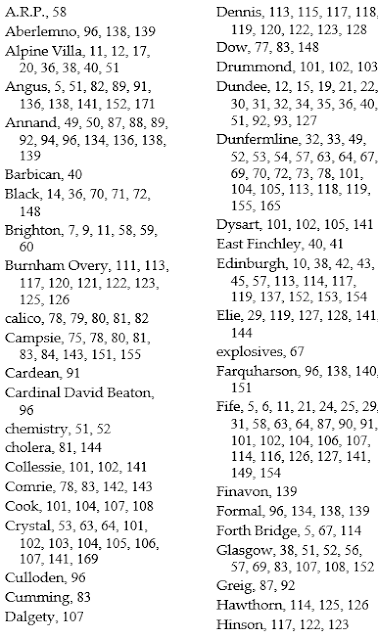The Science or Art of Indexing (Cecilia Peartree)
During April 2022 I did something I had never done before.
This is not as exciting as it sounds, though I was unreasonably excited by the
result. I think my former career in database-wrangling played a large part in
the excitement, because I spent at least some of my working life trying to make
it easier for people to search for information. These efforts were often foiled
by people’s reluctance to use the search tools available, but that’s another
story.
I’ve already written on this blog about the family history
narrative I published last year. Although it was framed by my own search back
through the generations, I did include a list of sources, which because of the
subject-matter incorporated places to visit – not that it was possible to visit
most of them in real life at the time I published. However it was only recently
that I thought of adding an index to the book. I don’t know why I didn’t think
of it in the first place, but it might have been because I imagined any
readers, who would all be drawn from my close family anyway, just starting at
the beginning and reading through to the end, whereas in fact some of them
might have wanted only to look up certain topics or places or family names and
go straight to the right page.
In any case I had always thought of the task of compiling an
index as something that would be beyond me, partly because of my complete
ignorance of how to go about it, and partly because I vaguely recalled a friend
having to do this some years ago, right at the end of the publication process for her scholarly
book about a specific aspect of 17th century history. It sounded
like a gruelling task, the way she talked about it. I pictured her wearing her
fingers to the bone working on a manuscript by candlelight, although in fact
this didn’t happen quite as long ago as the image below might suggest.
I didn’t think Microsoft Word would have the answer, but
because I’ve previously managed to persuade it to do many things I had imagined
were beyond its scope, such as starting the page numbering of a document on
page 3 or 5 instead of the first page, and creating a table of contents with
more than one level of headings, I thought I would have a look at the menus
there and see if there was an ‘Index’ option. Sure enough, there it was under the heading ‘References’.
There were a few false starts but not nearly as many as I
had expected. Unlike the use of sections to get the page numbering right, which
I used to have to work out again from first principles every time, it was
fairly obvious how this worked. You had to use the ‘Mark Entry’ option to mark
the words you wanted to appear in the index, and then click on ‘Insert Index’.
I marked a few entries one at a time, not daring to select the ‘Mark All’
option, before realising that using ‘Mark All’ would in fact painlessly gather
up all the matching words and combine them into one entry in the resulting
index.
I suppose the ‘art’ aspect of this is in choosing the right
words to mark up – in the case of the subject-matter I was working with, this
wasn’t too hard. I mostly included family names and place names, with a few
other keywords I thought might be of interest, such as calico, cholera and
explosives. The men in that branch of my family were not terrorists but quarry
workers, by the way.
Apologies to anyone reading for whom this is all really
obvious – I just couldn’t believe it was so simple.
Here’s an image of a page from my index, which I can’t help
gloating over!


Comments